GE HEALTHCARE OPTIMA XR200AMX/XR220AMX
D
IRECTION 5336113-1EN, REVISION 10 INSTALLATION MANUAL
Page 16 Preface
Computer Screen Output/Input Text Character Styles
Within this publication, mono-spaced character styles (fonts) are used to indicate computer text
that’s either screen input and output. Mono-spaced fonts, such courier, are used to indicated text
direction. When you type at your keyboard, you are generating computer input. Occasionally you
will see the math operator “greater-than” and “less-than” symbols used to indicate the start and
finish of variable output. When reading text generated by the computer, you are reading it as
computer generated output. In addition to direction, characters are italicized (e.g. italics) to indicate
information specific to your system or site.
Example: Fixed
Output
This paragraph’s font represents computer generated screen “fixed” output.
Its output is fixed from the sense that it does not vary from application
to application. It is the most commonly used style used to indicate
filenames, paths and text that do not change from system to system. The
character style used is a fixed width such as courier.
Example:
Variable Output
This paragraph’s font represents computer screen output that is
“variable”. It is used to represent output that varies from application
to application or system to system. Variable output is sometimes found
placed between greater-than and less-than operators for clarification. For
example: <variable_ouput> or <3.45.120.3>. In both cases, the < and >
operators are not part of the actual input.
Example: Fixed
Input
This paragraph’s font represents fixed input. It is computer input that
is typed-in via the keyboard. Typed input that does not vary from
application to application or system to system. Fixed text the user is
required to supply as input. For example: cd /usr/3p
Example:
Variable Input
This paragraph’s font represents computer input that can vary from
application to application or system to system. With variable text, the
user is required to supply system dependent input or information. Variable
input sometimes is placed between greater-than and less-than operators.
For example: <variable_input>. In these cases, the (<>) operators would
be dropped prior to input. For example: ypcat hosts | grep <3.45.120.3>
would be typed into the computer as:
ypcat hosts | grep 3.45.120.3
without the greater-than and less-than operators.
Buttons, Switches and Keyboard Inputs (Hard & Soft Keys)
Different character styles are used to indicate actions requiring the reader to press either a hard or
soft button, switch or key. Physical hardware, such as buttons and switches, are called hard keys
because they are hard wired or mechanical in nature. A keyboard or on/off switch would be a hard
key. Software or computer generated buttons are called soft keys because they are software
generated. Software driven menu buttons are an example of such keys. Soft and hard keys are
represented differently in this publication.
Example: Hard
Keys
A power switch ON/OFF
or a keyboard key like ENTER is indicated by applying a character style
that uses both over and under-lined bold text that is bold. This is a hard key.
Example: Soft
Keys
Whereas the computer MENU
button that you would click with your mouse or touch with your hand
uses over and under-lined regular text. This is a soft key.

